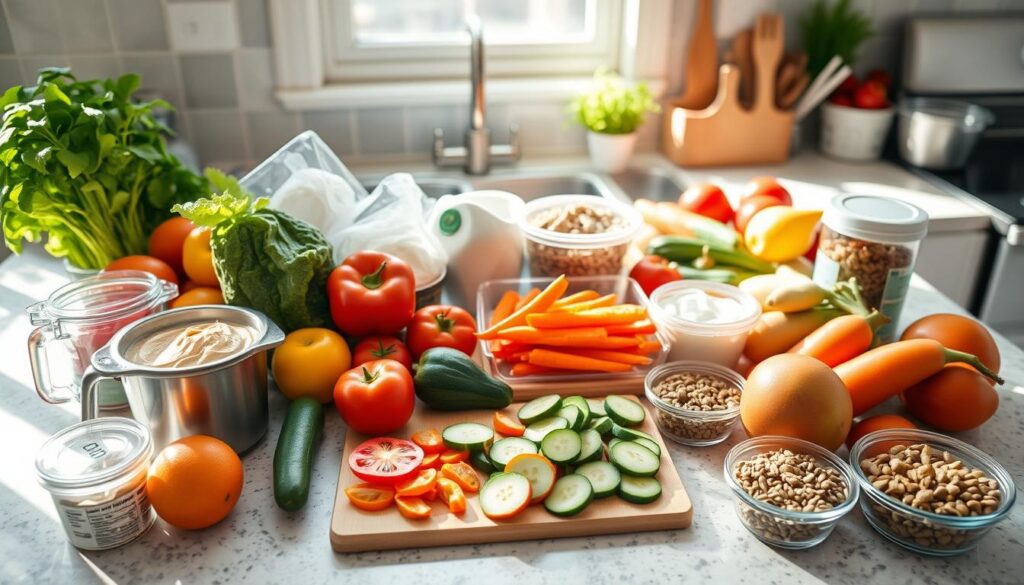Learning to prepare snacks for the week can change how you eat. Meal prep is more than a trend; it’s a smart move for those with busy lives. By spending a little time on planning your meals, you can have tasty, healthy snacks ready anytime.
Healthy snacks don’t need to be hard to make or expensive. They’re about planning well, using simple methods, and finding the right balance between taste and ease. Whether you work hard, love to stay active, or care about your health, making snacks ahead of time can make a big difference in your diet.
Key Takeaways
- Meal prep saves time and reduces daily food stress
- Healthy eating becomes easier with advance preparation
- Simple techniques can transform snack quality
- Nutritious snacks support overall wellness
- Strategic planning leads to consistent healthy choices
Why Meal Prepping Healthy Snacks is Essential for a Balanced Lifestyle
Nutrition planning is key to a healthy lifestyle. Preparing snacks ahead changes how we eat, making diet management easier.
Snack prep does more than save time. It boosts wellness and keeps diet consistent.
Benefits of Weekly Snack Preparation
- Reduces impulsive food choices
- Supports consistent nutrition intake
- Helps maintain steady energy levels
- Promotes mindful eating habits
Time and Money Savings
| Aspect | Weekly Snack Prep Impact |
|---|---|
| Time Saved | 3-5 hours per week |
| Money Saved | $30-$50 per week |
| Impulse Purchase Reduction | Up to 70% |
Health Impact of Planned Snacking
Smart snack planning boosts nutrition. Intentional food choices help control diet, avoiding unhealthy snacks.
“Planning your snacks is like creating a roadmap for nutritional success” – Nutritional Expert
Adding snack prep to your week leads to a healthier life. It’s all about being consistent and careful with your choices.
Kitchen Tools and Storage Containers You'll Need
Starting meal prep right means having the right tools and containers. The right containers can make snack prep easy and organized.
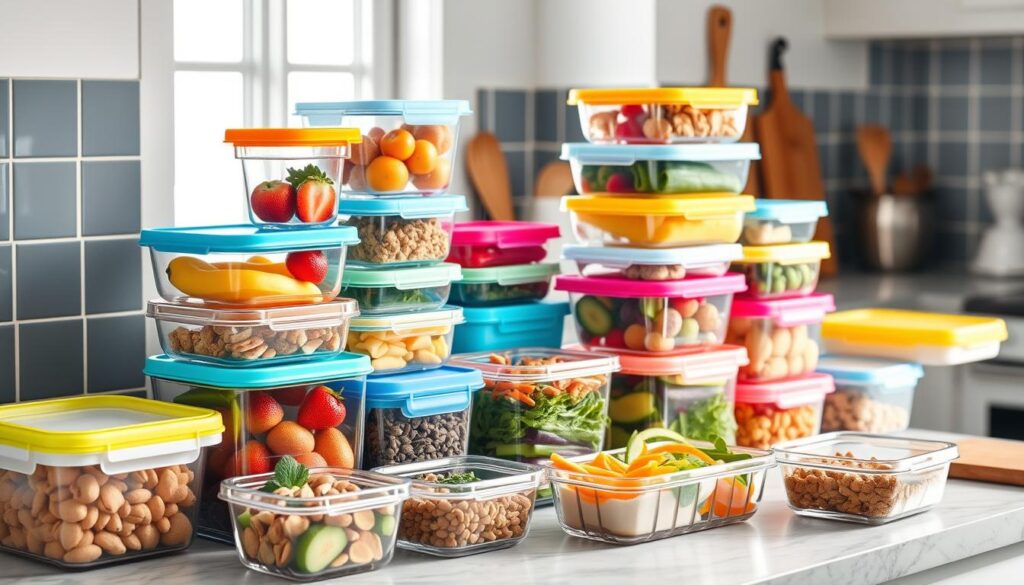
Meal prep isn’t just about plastic boxes. Today’s food storage solutions have cool features. They keep your snacks fresh and tidy.
- Glass containers with snap-lock lids
- Silicone collapsible containers
- Portion-controlled meal prep containers
- Vacuum-sealed storage options
When picking kitchen gadgets for meal prep, think about these:
- Durability: Containers that last a long time
- Size variety: Containers for all your snacks
- Leak-proof design: Stops spills
- Microwave and dishwasher compatibility: Easy to clean and use
“The right container can make meal prepping a joy, not a chore.” – Professional Nutritionist
Choose top-notch meal prep containers for your food’s health and taste. Stainless steel, glass, and BPA-free plastic are great for keeping your food safe.
Smart Shopping Tips for Weekly Snack Preparation
Starting with smart grocery shopping is key to healthy snacks. Planning your ingredients well makes meal prep easy. The right shopping strategy saves money, cuts waste, and keeps you stocked with healthy foods all week.
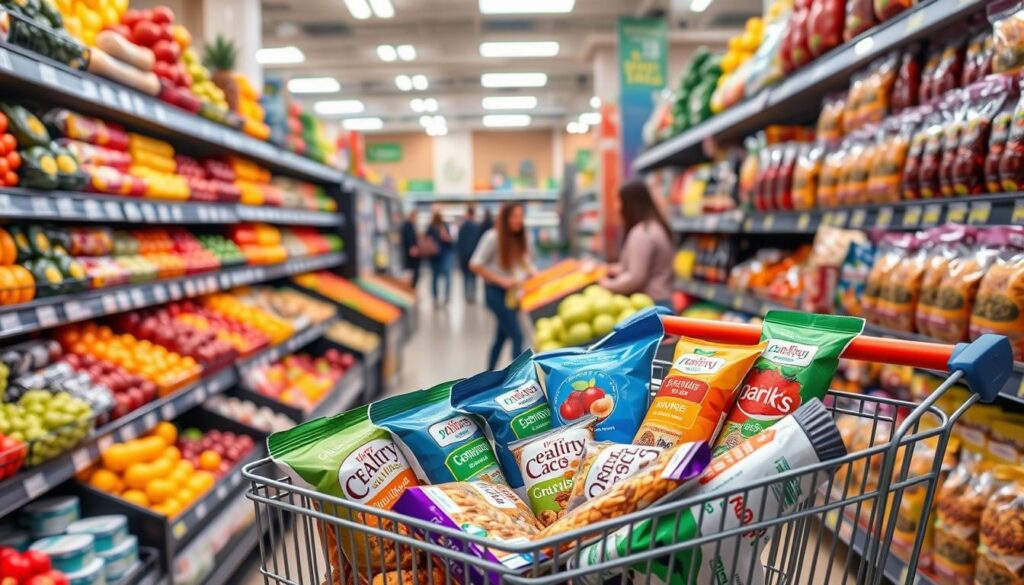
For successful snack shopping, you need a solid plan. Aim to get the freshest items without spending too much.
Creating an Efficient Shopping List
A detailed shopping list is your best tool for saving money. Here’s how to make one:
- Plan your meals and snacks first
- Check what you already have at home
- Order your list by store sections
- Stay true to your list
Choosing the Freshest Ingredients
Choosing the best produce is essential for tasty snacks. Look for fruits and veggies that are bright and firm.
- Check for any damage or soft spots
- Choose seasonal items for the best taste
- Consider frozen options for longer freshness
“The key to great snacks is starting with great ingredients.” – Nutrition Expert
Budget-Friendly Options
Smart shoppers find ways to eat well without spending a lot. Here are some tips:
- Buy big packs of things you use a lot
- Compare prices to find the best deals
- Opt for generic over brand-name
- Use sales and loyalty programs
With these tips, you’ll make snack prep easy and affordable. Enjoy making delicious, healthy snacks without spending a lot.
The Easiest Ways to Prep Healthy Snacks for the Week
Learning to prep quick snacks can change how you plan meals and save time on busy days. It makes healthy snacks easy for anyone, no matter their cooking skills.
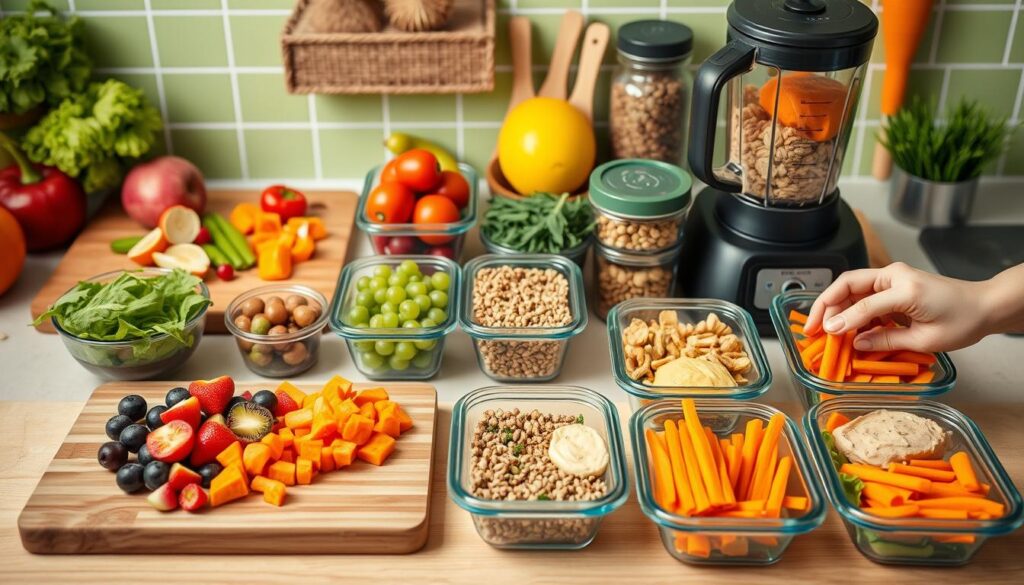
Start with planning and organizing to save time. The best way to plan meals is to find a simple method. This way, you spend less time in the kitchen and eat healthier.
- Batch cooking protein-rich ingredients
- Pre-cutting vegetables and fruits
- Creating portion-controlled containers
- Utilizing assembly-line preparation methods
“Preparation is the secret sauce of healthy eating” – Nutrition Expert
Using a clear plan for snack prep can cut down on stress and boost your diet. Try setting aside 1-2 hours each week for snack prep.
| Preparation Method | Time Investment | Snack Variety |
|---|---|---|
| Batch Cooking | 2 hours | 5-6 different snacks |
| Individual Portioning | 45 minutes | 3-4 snack types |
| No-Cook Prep | 30 minutes | 2-3 grab-and-go options |
Pro tip: Invest in quality storage containers to keep your prepared snacks fresh and accessible throughout the week.
No-Cook Snack Ideas for Busy Professionals
Working a busy schedule doesn’t mean you have to skip healthy food. Quick, easy no-bake snacks are perfect for professionals. They can be made in just a few minutes.
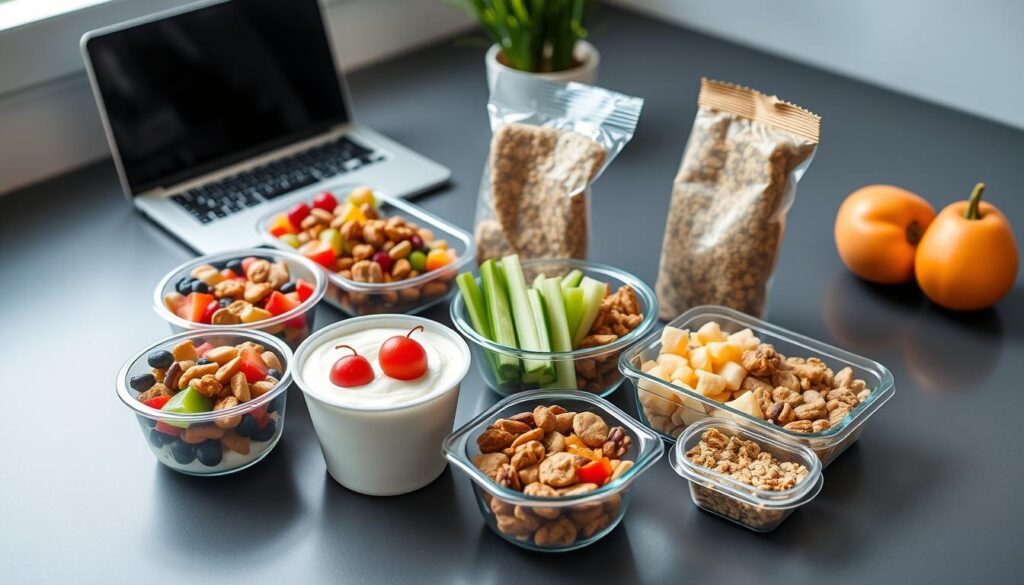
Busy people need snacks that give energy fast. The right snacks can make your workday better. They help you stay focused and full of energy.
Quick Assembly Options
- Greek yogurt parfaits with pre-chopped nuts
- Hummus with pre-cut vegetable sticks
- Overnight chia seed puddings
- Protein-rich energy balls
Grab-and-Go Combinations
| Snack Combination | Protein (g) | Prep Time |
|---|---|---|
| Apple slices + almond butter | 5 | 2 minutes |
| Hard-boiled eggs + cherry tomatoes | 12 | 5 minutes |
| Cottage cheese + berries | 14 | 3 minutes |
Portion Control Strategies
Smart snacking is about quality and quantity. Use small containers or portion-sized bags to prevent overeating. Prepare snack packs in advance to ensure consistent, controlled nutrition throughout your workweek.
“Preparation is the key to healthy eating in a busy world.” – Nutrition Expert
These no-cook snack ideas are designed to keep you satisfied, energized, and on track with your health goals. They don’t take up a lot of time during your busy workday.
Fresh Fruit and Vegetable Prep Techniques
Learning how to prepare produce is key for tasty fruit and veggie snacks all week. The right techniques keep nutrients in and snacks fresh and healthy.
- Rinse all fruits and vegetables under cool running water
- Use a clean vegetable brush for produce with firm surfaces
- Pat dry with clean paper towels to prevent bacterial growth
How you cut and store fruits and veggies affects their freshness. It also makes snacking easier.
| Produce Type | Best Cutting Method | Storage Recommendation |
|---|---|---|
| Berries | Leave whole, remove stems | Store in ventilated container |
| Carrots | Julienne or stick cut | Store in water in refrigerator |
| Apples | Slice into wedges | Sprinkle with lemon juice |
“Preparation is key to enjoying fresh, nutritious snacks throughout the week.” – Nutrition Expert
For the best nutrition, cut fruits and veggies just before eating. Store them in airtight containers to keep them fresh.
- Quick-access containers make grab-and-go snacking easier
- Use clear containers to visualize your healthy options
- Label containers with preparation dates
Protein-Rich Snack Combinations That Last
Creating snacks high in protein is key for a healthy diet. Whether you need snacks for workouts or to keep energy up, planning your protein meals can change your diet for the better.
Plant-Based Protein Options
Vegan snacks are great for lasting energy. Here are some tasty and healthy options:
- Roasted chickpeas with nutritional yeast
- Chia seed pudding with almond milk
- Edamame hummus with vegetable sticks
Animal Protein Preparations
For those who eat meat, there are many tasty protein snacks. Protein meal prep can make these snacks easy and satisfying. Try these:
- Hard-boiled eggs with everything bagel seasoning
- Turkey roll-ups with cheese and spinach
- Greek yogurt parfaits with granola
Storage Tips for Protein Snacks
Keeping your protein snacks fresh is important. Use airtight containers and follow these tips:
| Protein Type | Refrigeration Time | Storage Recommendation |
|---|---|---|
| Plant Proteins | 3-5 days | Sealed glass containers |
| Animal Proteins | 2-3 days | Vacuum-sealed bags |
“Meal prepping protein snacks isn’t just about nutrition—it’s about creating sustainable, delicious eating habits.”
Make-Ahead Energy Bites and Bars
Making homemade energy bars and protein balls is a big win for those who care about their health. These snacks are full of nutrients and easy to make. They let you power up with good stuff in just a few minutes.
It’s simple to make healthy snacks at home. Just pick ingredients that are full of nutrients and energy.
- Base ingredients for protein balls
- Essential binding agents
- Flavor enhancement techniques
Here’s a quick guide to making tasty protein balls:
- Choose a protein base (nuts, seeds, oats)
- Select natural sweeteners
- Add nutritional boosters
- Mix and roll into bite-sized portions
| Ingredient | Nutritional Benefit | Quantity |
|---|---|---|
| Almond butter | Healthy fats | 1/2 cup |
| Chia seeds | Omega-3s | 2 tbsp |
| Honey | Natural sweetener | 3 tbsp |
“Homemade energy bars are not just snacks, they’re portable nutrition powerhouses!” – Nutrition Expert
Try out different mixes to find your favorite healthy snack. Remember, the best protein balls are those tailored to your personal taste and nutritional needs.
Storage Solutions and Food Safety Guidelines
Keeping your snacks safe needs smart storage tips. It’s more than just putting containers in the fridge. Knowing the right ways can keep your food fresh and safe from illness.
Proper Container Selection
Choosing the right containers is key for keeping snacks fresh. Glass and BPA-free plastic with tight lids are best. They keep food fresh and stop contamination.
- Choose clear containers for easy ingredient visibility
- Opt for leak-proof designs
- Select containers with compartments for separating ingredients
Temperature Control Tips
Keeping snacks safe and tasty needs the right fridge settings. Each food has its own temperature needs to stay good and stop bacteria.
| Food Type | Ideal Storage Temperature | Maximum Storage Time |
|---|---|---|
| Cut Fruits | 40°F (4°C) | 3-5 days |
| Protein Snacks | 35-38°F (2-3°C) | 3-4 days |
| Vegetable Sticks | 40°F (4°C) | 5-7 days |
Shelf Life Guidelines
Knowing when to toss snacks is part of food safety. Always look for signs like bad smells, color changes, or texture issues.
“When in doubt, throw it out” – Food Safety Experts
- Label containers with preparation dates
- Use transparent containers for easy monitoring
- Rotate snacks to consume oldest preparations first
Smart storage isn’t just about preservation—it’s about maintaining the nutritional integrity and safety of your carefully prepared meals.
Conclusion
Learning to prepare snacks for the week can change your eating habits for the better. It turns meal planning into a simple routine that helps you stay healthy. This approach offers more than just convenience.
Spending time on snack prep sets up a strong foundation for healthy eating. It helps you make better food choices and avoid unhealthy snacks. This way, you keep your body fueled with good nutrients, even when you’re busy.
Small steps can lead to big health benefits. Whether you’re busy at work or focused on wellness, planning snacks can change how you view food. Your kitchen becomes a place where you make healthy choices, giving you energy and vitality.
Improving your snack prep skills is a process. Begin with easy steps, try new ingredients, and grow your confidence in planning meals. Your body will thank you for choosing to eat mindfully and with purpose.
FAQ
How long can prepped snacks typically last in the refrigerator?
Most snacks can stay fresh for 3-5 days in the fridge. Cut fruits and veggies are best eaten in 2-3 days. Protein snacks like hard-boiled eggs can last up to 7 days if stored right.
What are the best containers for meal prepping snacks?
Choose BPA-free containers with tight lids. Glass containers with sections are great for mixing ingredients. Mason jars are perfect for layered snacks. Silicone or plastic containers also keep snacks fresh and prevent contamination.
Can I prep snacks for the entire week in one session?
Yes, you can! Batch cooking saves time. Spend 1-2 hours on the weekend to chop veggies, portion nuts, make energy bites, and pack snacks. This way, you have healthy snacks all week.
How can I keep fruits and vegetables fresh during meal prep?
Keep produce fresh by washing it just before storing. Use containers that breathe and keep wet items separate. Cut fruits with lemon juice to stop browning. Use bags or containers with air holes for veggies.
Are make-ahead snacks budget-friendly?
Yes, they are! Meal prepping can cut down on food costs. Buying in bulk, choosing seasonal produce, and making snacks at home is cheaper than store-bought. It also reduces waste and saves money.
What are some protein-rich snack ideas that are easy to prep?
Good protein snacks include hard-boiled eggs, Greek yogurt with nuts, and hummus with veggies. Turkey and cheese roll-ups, energy balls, and cottage cheese with fruit are also great options.
How can I make sure my prepped snacks remain food-safe?
Keep snacks safe by using clean surfaces, washing hands, and storing at the right temperature. Use airtight containers and label them with dates. Always eat within the recommended time.
Can I prep snacks if I follow a specific diet like vegan or keto?
Yes, you can! Meal prepping works for all diets. Vegans can make chickpea salads, nut butter with apples, and veggie energy bites. Keto dieters can prep cheese crisps, hard-boiled eggs, and low-carb veggie sticks with dips.
Share this post: on Twitter on Facebook

